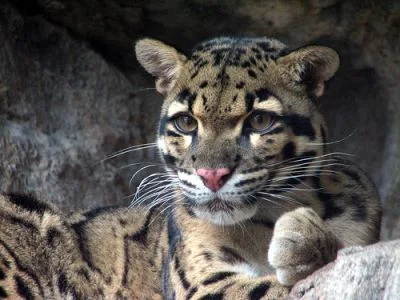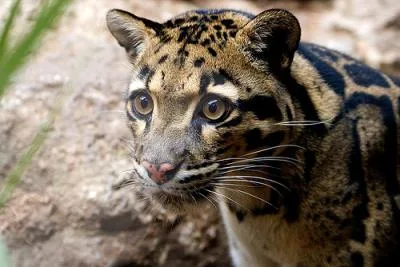
Clouded Leopard photo by The Brit_2 and published under a creative commons license
Here are three of the best clouded leopard photos. They are selected from Flickr photographers who have kindly granted a right to publish under a creative commons license. Of course they are all taken in zoos as nearly all clouded leopard photos will be; an indication once again of the fragile a position in which we place such beautiful wildcats usually by habitat loss as a result of mankind's voracious commercial activities.

Clouded Leopard photo by fuzuoko
For me three things are noticeable about this gorgeous wildcat. The spots are similar but much larger than the spots of a some Bengal cats. Their shape and design have the appearance of clouds hence the name.
The other is the size. This is quite a small wildcat in relation the size of other wildcats that we are more familiar with; I mean the big cats such as the tiger, the biggest wildcat. The Clouded Leopard is medium sized weighing 33-50 lbs. At the bottom end of 33 lbs this cat is only slightly heavier than the biggest domestic cats such as the Savannah (F1 or F2) cat a wildcat hybrid. The Maine Coon a domestic cat for hundreds of years can weigh (although unusually) in the region of 25 lbs. So this is quite a small wildcat really.

The third noticeable feature is the extraordinary length of the Clouded Leopard's tail, which you can see in this nice Clouded Leopard photo adjacent by guppiecat. This cat also has very long canine teeth at 2 inches the longest of any living (as opposed to extinct) feline. The extinct Saber Tooth Tiger probably had the longest.
Why is the tail so long? The answer is in the sort of prey this cat hunts, which includes macaques and gibbons, both tree dwellers and fantastic climbers.
The clouded leopard is also a fantastic climber. A domestic cat that is a fantastic climber is the Norwegian Forest cat.
This wildcat has a long tail to help maintain balance. The tail can be as long as the body. Large paws and an extremely athletic body make for excellent climbing skills including running down trees head first. My half Norwegian Forest cat could do that too.
Amazingly we don't know much about this cat. There are perhaps 10,000 in the world (2008). A camera trap recently photographed one in the Borneo jungle of Sebangau National Park in Central Kalimantan. This is jungle that has been logged excessively (another example of habitat destruction without taking responsibility for the wildlife depending on it). The Borneo Clouded Leopard is the top predator in Borneo.
Camera traps (camera
 s that take photographs automatically when triggered by a movement sensor) are a good way of researching the population, movement and habits etc. of this elusive and beautiful animal.
s that take photographs automatically when triggered by a movement sensor) are a good way of researching the population, movement and habits etc. of this elusive and beautiful animal.I have taken the liberty of reproducing the camera trap photograph here (see adjacent - left). It is probably copyrighted to Oxford University’s Wildlife Conservation Research Unit and Indonesia’s Pangkalan Raya University. Notice the reflective eyes.
If there is an issue in publishing the photo here please tell me and I will remove it. Clouded leopard photos of non captive cats are hard to come by.
The Clouded Leopard has the hardest bite of all the cats
Go to more on the Clouded Leopard
From Clouded Leopard Photos to Cheetah habitat
Clouded leopard photos - Source:
Go to more on the Clouded Leopard
From Clouded Leopard Photos to Cheetah habitat
Clouded leopard photos - Source:
- Wikipedia
- The Daily Times (of Pakistan) http://www.dailytimes.com.pk

The Sunda Clouded Leopard -
ردحذفThere is some important research explaining a great deal of new material about the clouded leopard on BBC webpage. Research coming out of Leibnitz Institute of Zoo and Wildlife Research says there are two categoric types:
" As well as the better known clouded leopard living on the Asian mainland (Neofelis nebulosa), scientists determined that a separate clouded leopard species lives on the islands of Borneo and Sumatra.
The two species are thought to have diverged over one million years ago.
This leopard is now known as the Sunda clouded leopard (Neofelis diardi), though it was previously and erroneously called the Bornean clouded leopard."